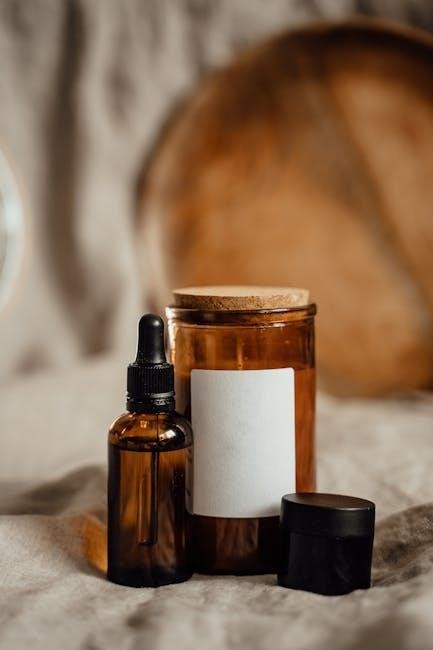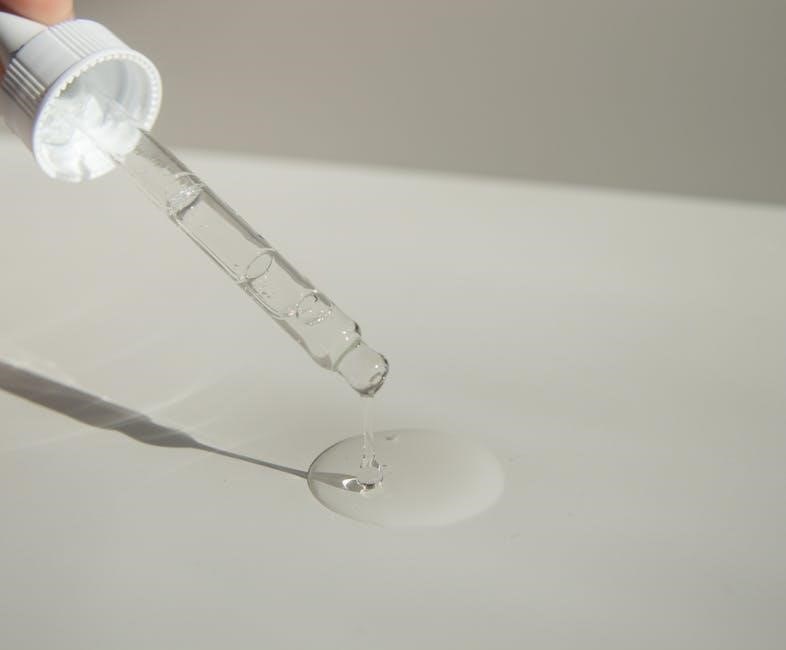Essential Oil Dilution Chart
Essential oils are concentrated and require proper dilution before topical application. Dilution charts provide ratios for safe use with carrier oils like almond, coconut, or jojoba. These charts are valuable tools to ensure effective and safe application for various uses.
Importance of Dilution
Diluting essential oils is crucial for safety and efficacy. Undiluted application can lead to skin irritation, sensitization, or allergic reactions. Essential oils are highly concentrated, and dilution reduces their potency to a safe level for topical use. Carrier oils, such as almond, coconut, or jojoba, not only dilute the essential oil but also aid in absorption and prevent rapid evaporation.
Proper dilution ensures that the essential oil is delivered effectively without overwhelming the body. It also helps to prolong the life of your essential oils, as you use less per application. Different essential oils have varying levels of potency, so it’s important to consult a dilution chart to determine the appropriate ratio for each oil. Children, pregnant women, and individuals with sensitive skin require even lower concentrations.
Dilution allows for broader application and reduces the risk of adverse effects, making essential oils a safe and beneficial addition to your wellness routine. Always prioritize safety by diluting essential oils before applying them to the skin.
Dilution Ratios
Understanding dilution ratios is paramount for safe and effective essential oil use. Ratios are typically expressed as a percentage of essential oil to carrier oil. A common dilution for adults is 2-3%, while children, the elderly, and those with sensitive skin require a 1% or lower dilution. For example, a 2% dilution equates to 12 drops of essential oil per ounce of carrier oil.
Specific applications may require different dilution ratios. For facial applications, a 0.5-1% dilution is recommended to minimize irritation. For body massage, a 2-3% dilution is generally suitable. In bathwater, essential oils should always be diluted in a carrier oil before adding to the bath to prevent skin irritation.
It’s essential to use accurate measurements when diluting essential oils. Using too much essential oil can lead to adverse reactions, while using too little may not provide the desired therapeutic benefits. Always consult a reliable dilution chart and adjust the ratios based on individual needs and sensitivities to ensure safe and effective use.
Carrier Oils (almond, coconut, jojoba)
Carrier oils are vegetable oils used to dilute essential oils before topical application. They help to reduce the potency of essential oils, making them safer for skin contact. Almond oil, derived from almonds, is a light and easily absorbed oil, rich in vitamin E and suitable for most skin types. It’s excellent for massage and skincare formulations.
Coconut oil, available in both fractionated and unrefined forms, offers moisturizing properties. Fractionated coconut oil remains liquid at room temperature and is odorless, making it a versatile carrier. Unrefined coconut oil has a distinct aroma and is solid at room temperature, providing extra emollient benefits for dry skin.
Jojoba oil, technically a liquid wax, closely resembles the skin’s natural sebum. It’s non-comedogenic, meaning it won’t clog pores, and is suitable for all skin types, including acne-prone skin. Jojoba oil has a long shelf life and offers moisturizing and protective qualities when combined with essential oils for various applications.

Printable PDF List of Essential Oils
Discover our alphabetical and printable PDF list of essential oils. Explore the properties, benefits, and uses of 60 essential oils. Download our chart/guide to quickly select the right oil for your needs.
Alphabetical List of 60 Essential Oils
This comprehensive list presents 60 of the most popular essential oils, arranged alphabetically for easy reference. Each entry provides a quick overview, making it simple to locate oils based on their name. From Anise with its licorice-like aroma to Ylang Ylang, known for its calming properties, this list covers a wide range of aromatic and therapeutic options.
The alphabetical format is designed to help users quickly find specific oils without needing to sift through extensive information. Whether you’re a seasoned aromatherapist or new to essential oils, this list serves as a handy reference guide. It includes commonly used oils such as Lavender, Frankincense, and Peppermint, alongside lesser-known options like Ho Wood and Balsam Fir.
Each entry is carefully curated to provide essential details, making it a valuable resource for both personal and professional use. The list is an excellent starting point for anyone looking to expand their knowledge of essential oils and their diverse applications.
Properties, Benefits, and Uses
Each essential oil in our list comes with a detailed description of its properties, benefits, and uses. Understand the unique chemical composition that gives each oil its distinct aroma and therapeutic effects. Discover how these oils can be used to support physical, emotional, and mental well-being.

Explore the diverse benefits of each oil, from Lavender’s calming properties to Peppermint’s invigorating effects. Learn how essential oils can be used to alleviate stress, improve sleep, boost immunity, and enhance overall health. This section provides practical information on how to incorporate essential oils into your daily routine for optimal results.

Discover various applications, including aromatherapy, topical use, and internal use (where appropriate and with proper guidance). Find out which oils are best suited for specific purposes, such as relaxation, focus, or energy. This comprehensive guide empowers you to make informed decisions about which essential oils to use for your individual needs and preferences. Understand contraindications and safety precautions for responsible use.
Downloadable Chart/Guide
To make accessing essential oil information even easier, we offer a downloadable chart and guide in PDF format. This comprehensive resource provides a quick reference for selecting the right essential oil for any need. The chart is designed for easy navigation, allowing you to quickly find information on properties, benefits, and uses.
The downloadable guide is perfect for both beginners and experienced essential oil users. It includes an alphabetical list of 60 essential oils, making it simple to locate specific oils. You can print the chart and guide for convenient use at home, in the office, or while traveling. Keep it handy for quick consultations whenever you need to select an oil.
With the downloadable PDF, you’ll have instant access to a wealth of essential oil knowledge. This handy resource empowers you to make informed decisions and effectively utilize the power of essential oils in your daily life. Download the chart/guide now and embark on a journey of natural wellness!

Essential Oil Uses in Daily Life
Discover the versatility of essential oils in your everyday routines. Incorporate them into cleaning recipes, diffuser blends, massage oils, and DIY beauty products. Explore the many ways to enhance your life with these natural wonders.

Recipes for Cleaning
Essential oils offer a natural and effective way to clean your home, providing a fresh scent and antibacterial properties. Create a simple all-purpose cleaner by mixing water, vinegar, and a few drops of lemon or tea tree oil. For disinfecting surfaces, combine eucalyptus or lavender oil with water in a spray bottle.
To freshen carpets and rugs, mix baking soda with your favorite essential oil, sprinkle it on, let it sit, and then vacuum. For a natural laundry boost, add a few drops of lavender or lemon oil to your washing machine. A DIY wood polish can be made using olive oil and orange essential oil, giving your furniture a beautiful shine.
Essential oils also work wonders in the bathroom. Use tea tree oil in a toilet bowl cleaner for its antifungal benefits. Diffusing lemon or grapefruit oil can help eliminate odors and create a fresh, clean atmosphere. These recipes offer a chemical-free alternative for a healthier home.
Diffuser Blends
Diffuser blends can transform your living space, creating various atmospheres using essential oils. For relaxation and stress relief, try a blend of lavender, chamomile, and frankincense. To boost energy and focus, combine rosemary, lemon, and peppermint oils. Create a calming bedtime blend with cedarwood, sweet marjoram, and vetiver.
During cold and flu season, diffuse a blend of eucalyptus, tea tree, and lemon oils to support respiratory health. For a refreshing and uplifting scent, mix grapefruit, bergamot, and lime. To promote romance and intimacy, try a blend of ylang-ylang, jasmine, and sandalwood.
When creating your own diffuser blends, consider the aroma and benefits of each oil. A good starting point is to use a combination of top, middle, and base notes to create a well-balanced fragrance. Experiment with different combinations to find your favorite blends for various moods and occasions.
Massage Oils
Creating massage oils with essential oils enhances the therapeutic benefits of massage, promoting relaxation, pain relief, and improved circulation. Use carrier oils such as sweet almond, jojoba, or grapeseed oil as a base, then add essential oils according to your desired effect.
For muscle relaxation, consider using lavender, marjoram, and Roman chamomile. These oils possess calming and anti-inflammatory properties that soothe sore muscles and reduce tension. To invigorate and energize, blend peppermint, eucalyptus, and rosemary. These oils can help improve circulation and relieve fatigue.
For stress relief, combine frankincense, bergamot, and ylang-ylang. These oils promote relaxation and reduce anxiety. When preparing massage oils, adhere to safe dilution guidelines, typically 1-3% essential oil concentration. Always perform a patch test before applying the oil to a large area of skin, and avoid using essential oils on broken or irritated skin. Store massage oils in dark glass bottles to protect them from light and air.
DIY Beauty Recipes
Essential oils can be incorporated into a variety of DIY beauty recipes to enhance skincare and haircare routines naturally. When creating these recipes, always prioritize safety by using appropriate dilution ratios and high-quality ingredients. For a revitalizing face serum, combine jojoba oil, frankincense, and lavender essential oils. This blend promotes skin regeneration and reduces the appearance of fine lines.

To make a nourishing hair mask, mix coconut oil, rosemary, and cedarwood essential oils. This mask strengthens hair follicles and stimulates hair growth.

For a soothing body scrub, combine Epsom salts, olive oil, and grapefruit essential oil. This scrub exfoliates dead skin cells and improves circulation. Always conduct a patch test before applying any DIY beauty product to ensure you do not have an allergic reaction. Essential oils like tea tree and lavender can be used for acne treatment, while chamomile and rose can soothe sensitive skin. Remember to store your DIY beauty creations in airtight, dark glass containers to maintain their potency and freshness.

Essential Oil Information Chart
An essential oil information chart provides quick insights into each oil’s aroma, compatible blends, and key benefits. These charts often list attributes like uplifting, balancing, or comforting, helping users select oils based on desired effects and applications.

Aroma
The aroma of an essential oil is a defining characteristic, influencing its application and perceived benefits. Different oils offer a wide spectrum of scents, ranging from floral and herbal to citrusy, spicy, and woody notes. For example, anise boasts a licorice-like, spicy aroma, while balsam fir presents a pleasant, woodsy scent. Patchouli is known for its rich, earthy, and woody fragrance.
The aroma plays a key role in aromatherapy, where specific scents are believed to evoke particular emotional and physiological responses. Lavender, with its calming and floral aroma, is often used to promote relaxation and improve sleep. Citrus oils like bergamot provide uplifting and energizing effects. Understanding the aroma of each essential oil allows users to create personalized blends and tailor their aromatherapy experiences to their needs.
Therefore, aroma is a vital aspect to consider when selecting essential oils for therapeutic or aromatic use.
Mixes Well With
Essential oils can be combined to create synergistic blends, enhancing their individual properties and creating unique aromatic experiences. Understanding which oils complement each other is crucial for effective blending. Anise, with its spicy aroma, mixes well with cedarwood, lime, orange, and vanilla, creating a balanced and uplifting blend. Atlas cedar, known for its sweet, woodsy scent, blends harmoniously with chamomile, cypress, eucalyptus, and sandalwood.
Bergamot, a citrus oil, combines well with geranium, jasmine, mandarin, nutmeg, orange, rosemary, and ylang-ylang. Cardamom, with its spicy and warm aroma, complements bergamot, cedarwood, clary sage, clove, frankincense, ginger, orange, and ylang-ylang. By carefully selecting oils that blend well together, you can create customized blends that target specific needs, whether for relaxation, energy, or respiratory support.
Experimentation and research are key to discovering your favorite combinations;
Benefits
Essential oils offer a wide range of therapeutic benefits, impacting both physical and emotional well-being. Anise essential oil is known for its uplifting, balancing, and comforting properties, promoting emotional stability and reducing stress. Atlas cedarwood provides grounding, centering, and balancing effects, helping to calm the mind and promote relaxation. Balsam fir offers empowering, balancing, and strengthening benefits, enhancing resilience and vitality.
Ho Wood is commonly used for influenza, colds, chills, and respiratory infections, as well as for skin conditions like eczema and acne. Lavender assists the body in adapting to occasional stress, soothes skin, and promotes restful sleep. Frankincense calms and relaxes, may help smooth the appearance of healthy-looking skin. Patchouli is known as an aphrodisiac, promotes relaxation and concentration, and may be beneficial for wrinkles, acne, and athlete’s foot.
These diverse benefits make essential oils valuable tools for supporting overall health and wellness.
